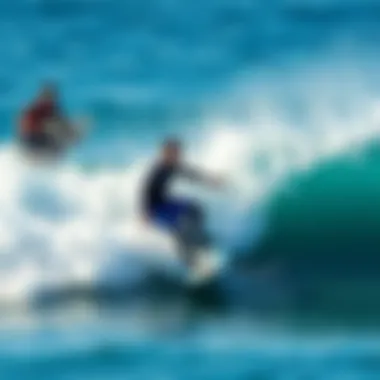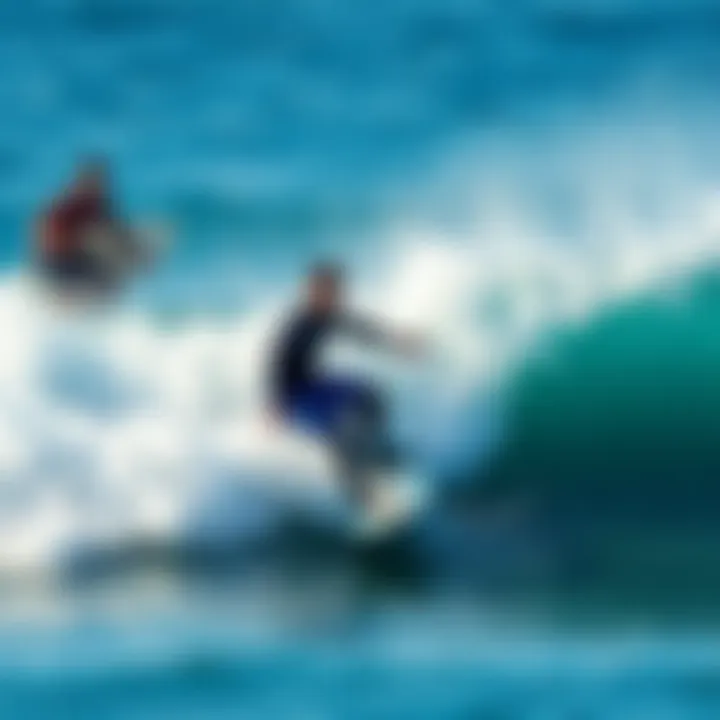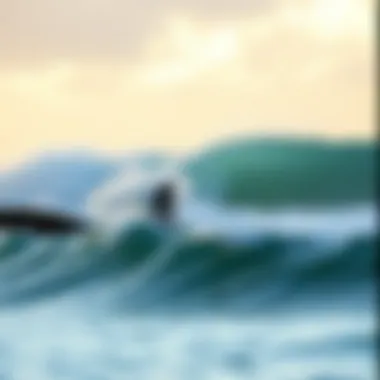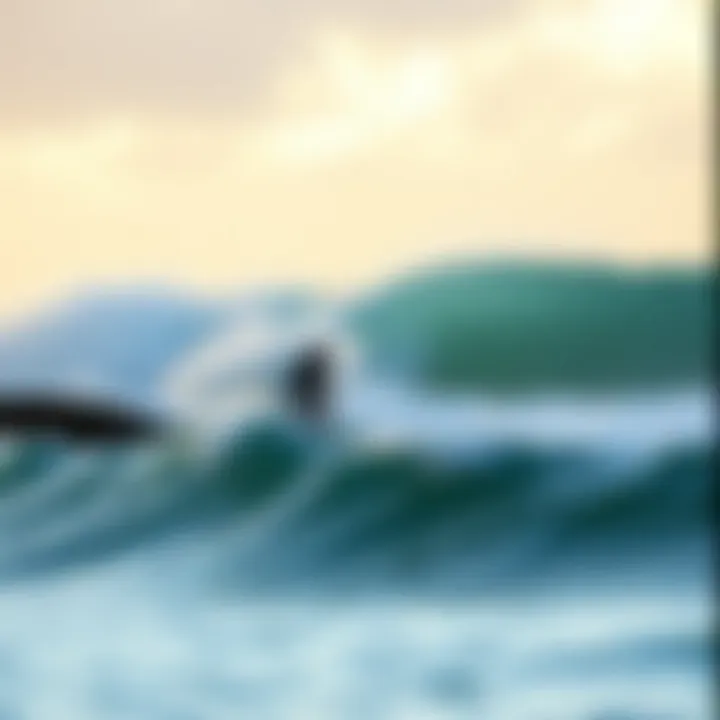Understanding Waves and Beaches: A Detailed Overview


Intro
Waves crashing against a beach are more than just a picturesque scene; they represent the choreography of natural forces and human culture entwined on the coastlines of the world. From the horizon, where the ocean meets the sky, to the damp sands beneath our feet, every whisper of the wind and each splash of the surf tells a story of powerful natural dynamics. This guide takes a holistic view of this relationship, delving into the physics of waves, their cultural prominence, and the contemporary issues facing our beloved beaches.
The intricate relationship between waves and beaches is vital not just for surfers and beachgoers but also for environmentalists and coastal communities. As waves carve away at the shore, they shape not only the physical landscape but also influence the activities and traditions that evolve in these settings.
With increasing focus on sustainability and climate awareness, the interaction between surf culture and environmental stewardship becomes ever more significant. By examining these waves in their many contexts, we grasp their enduring impact on our lives and the urgent need for their preservation and understanding.
In this article, we will explore the following topics:
- Physical properties of waves and their behaviors
- Surfing techniques and their evolution
- Cultural significance and lifestyle tied to surfing
- Environmental considerations affecting beaches and surf culture
By intertwining the scientific with the cultural, we aim to provide readers not just with knowledge about the workings of waves, but insights into the deeper stories and responsibilities that accompany our coastlines.
"To truly enjoy a wave, one must understand the dance of nature that creates it."
As we embark on this exploration, let's start with the fundamental knowledge of surfing techniques, the bedrock on which all surf culture is built.
Understanding Waves
Waves are not just a pretty sight; they are dynamic entities that shape our coastlines and influence oceanic behaviors. Understanding waves is crucial for several reasons, especially when discussing the delicate relationship between them and beaches. Waves are the primary architects of coastal landforms, impacting erosion and sediment transport, thus playing a significant role in beach morphology. Furthermore, they are vital for recreational activities, especially surfing, where various wave types cater to different skill levels and experiences. Understanding these fundamental concepts leads surfers and beachgoers alike to appreciate the ocean's power and beauty.
Types of Waves
Wind waves
Wind waves are the most common variety, generated by the wind's friction against the water's surface. This friction creates ripples that can grow into larger waves under sustained wind. One key characteristic of wind waves is their size, which can vary from mere ripples to towering swells, depending on wind strength and duration. Wind waves are significantly relevant to surfers as they offer various conditions that cater to different surfing styles and challenges. However, they can also be quite unpredictable; for example, on a calm day, one might not expect an outstanding swell, yet suddenly, conditions could shift, resulting in excellent surf conditions.
Seismic waves
Seismic waves, originating from tectonic activity, present a different phenomenon altogether. These waves are critical for understanding geological structures beneath the ocean floor. One key characteristic is the immense energy behind them, which can cause substantial disruptions in water. Though seismic waves are not directly related to an enjoyable day at the beach, knowing about them is essential for coastal safety. Their examination helps reveal potential risks for tsunamis that may arise from underwater earthquakes. By understanding seismic waves, coastal communities can prepare better for rare yet hazardous events.
Tsunamis
Tsunamis are large and destructive waves often caused by underwater earthquakes or volcanic eruptions. One notable feature of tsunamis is their wave period, which can be hours long between waves, compared to the shorter intervals of wind waves. While they are immensely powerful, they are infrequent, but the threat they pose makes them an essential consideration. Unlike the typical swell surfers seek, tsunamis arrive rapidly, gaining height and speed as they approach the coast, causing catastrophic damage to beaches and infrastructure. To protect coastal environments and communities, understanding tsunami dynamics is vital.
Wave Formation
The role of wind
Wind is the primary driver in the formation of ocean waves. As wind travels across the sea surface, friction acts like a brush against the canvas, creating ripples that evolve into complex wave patterns. Key characteristics of wind's role include the distance traveled—the longer the fetch, or distance over which the wind blows, the larger the wave can grow. This is painterly in nature because, akin to a skilled artist, the wind crafts waves differently depending on its strength and duration.
Fetch and wave height
Fetch refers to the stretch of water over which the wind moves. It is one of the most crucial factors affecting wave height. A key characteristic of fetch is that a greater distance allows for larger waves to form, given that winds have more time to exert energy into creating and building them. This feature is significant for surfers who seek out locations with extensive fetch, leading to robust surf conditions.
Swell dynamics
Swell dynamics encompass the movement of waves after they have been generated. Once wind waves travel away from their source, they can organize into swells, which represent longer, more consistent wave patterns. Key characteristics include periods and distance between waves, which determine surfing conditions. Predicting swell activity is crucial for timely and dangerous forecasting. Healthy swell dynamics lead to a superior surfing experience, dramatically reshaping how surfers plan their outings.
Wave Properties
Wavelength
Wavelength refers to the distance from one wave crest to the next. It significantly impacts the characteristics of the wave, including its behavior and speed in different conditions. The unique feature of wavelength is its direct connection to energy; longer wavelengths generally carry more energy, creating robust swells perfect for surfing. Understanding wavelength can help surfers choose optimal conditions for riding, enhancing their performance in the water.
Wave speed
Wave speed is the rate at which the wave travels across the ocean surface. This speed is influenced largely by the wave's height and wavelength. One key characteristic about wave speed is its variability; stronger, higher waves generally move faster. Surfers must be aware of this property to time their rides accurately, making wave speed a crucial consideration for both fun and safety.


Wave frequency
Wave frequency refers to how many waves pass a specific point in a given time. This attribute is significant because it affects the overall energy of the water surface. A unique feature of wave frequency is its direct correlation with surf conditions—high-frequency waves can lead to rapid, choppy waters while lower frequencies allow for smooth rides. Understanding wave frequency enables surfers to select the best times to hit the waves and enhances their overall experience.
The Coastal Environment
The coastal environment is an intricate web of natural processes and unique characteristics that define our shorelines. As the interface between land and sea, it plays a crucial role not only in physical geography but also in ecological and human contexts. Understanding this environment helps us appreciate the dynamics at play, particularly how waves interact with beaches, which ultimately shapes the surfing culture we cherish.
Beach Morphology
Types of beaches
Beaches can vary widely, creating different landscapes and experiences for those who visit. Sandy beaches are perhaps the most iconic, often stretching under a bright sun, inviting family picnics and sunbathers alike. However, rocky beaches provide a rugged alternative, often popular amongst those seeking a picturesque vista or tidal pools filled with marine life.
In terms of contribution, the soft powdery sands of tropical beaches often draw in tourists looking for leisure and relaxation, while the pebbly shores of certain coastal regions may attract surfers seeking the perfect break. With each beach type comes its own set of characteristics and benefits that cater to different activities and preferences. For instance, sandy beaches are renowned for their gentle slopes, ideal for families, whereas rocky beaches can pose challenges but offer excellent spots for fishing and exploration.
Sediment transport
Sediment transport is the lifeblood of any coastal ecosystem. It refers to the movement of sand and other materials along the coastline due to wave action, currents, and human activity. This process is fundamental for shaping beaches and ensuring their vitality. Over time, the dynamic interplay of these forces can lead to significant transformations in beach morphology.
This aspect not only contributes to the aesthetics of the beach but also plays a vital role in maintaining habitats for many species. Disruptions in sediment transport can lead to beach erosion, adversely affecting both wildlife and human populations. Thus, understanding sediment transport is essential for anyone interested in beach conservation and management strategies.
Beach erosion and accretion
Beach erosion and accretion are two sides of the same coin, often battling for dominance along coastlines. Erosion occurs when wave action, currents, or storms remove sand faster than it can be replenished. This phenomenon can lead to significant loss of land and affect local ecosystems. On the flip side, accretion happens when sediment is deposited along the shore, slowly rebuilding the beach.
Appreciating these processes helps us understand the delicate balance required to maintain healthy coastal environments. For example, eroding beaches may result in loss of property and habitats while accreting beaches may broaden the recreational areas available to visitors. Each of these processes has advantages and disadvantages worthy of consideration within the broader context of coastal management and conservation efforts.
Wave-Climate Interactions
Seasonal variations
Seasonal variations have a profound influence on wave heights and frequencies, introducing a rhythmic dance to coastal environments. These changes can dictate the kinds of surf conditions surfers will experience, with summer typically bringing smaller, more manageable waves and winter unleashing powerful swells.
For many surfers, the anticipation of these variations is what fuels their passion. This cyclical nature also impacts local economies reliant on tourism during peak seasons, with families flocking to enjoy the sun and surf in warmer months while autumn and winter open the door for a more serious surf crowd.
Long-term climate impacts
Climate change presents a long-term challenge that alters wave patterns and coastal dynamics. Rising sea temperatures can lead to more intense storms, which in turn may increase erosion rates and change the characteristics of beaches. Understanding these changes is essential for surfers who want to stay ahead of the curve when it comes to wave conditions and safety.
Additionally, there are broader implications for coastal communities. Coastal infrastructure may face increased risk from flooding, prompting shifts in policies around zoning and land use. Thus, grasping the long-term impacts of climate change is key for both surfers and environmentalists concerned with the future integrity of coastal environments.
Storm surges
Storm surges are rapid increases in sea level caused by extreme weather events, significantly affecting coastal ecosystems and human habitats. The destructive energy of storm surges can reshape shorelines, uprooting buildings and habitats alike. For surfers, a knowledge of how storm surges operate can influence not only their safety but also their choice of surf spots before and after such events.
Moreover, these surges highlight the need for robust coastal management strategies. Beach restoration and vegetation planting can serve as a buffer against storm impacts, preserving not only recreational areas but also vital ecosystems that help filter pollutants and protect marine life. Knowing the role of storm surges enables better preparation and response, fostering resilience in our coastal communities.
Surfing Culture
Surfing culture is not just a leisure activity; it embodies a lifestyle that resonates with those who seek adventure and connection with nature. Within this article, we'll dive into the rich aspects of surfing culture that make it integral to understanding the dynamic interplay between waves and beaches. Surfing is steeped in history, with deep cultural roots across various societies. It offers insights not only into recreational pursuits but also into societal transformations led by the surf industry. This section aims to highlight the importance of these surf-related elements, exploring their significance in modern contexts and their implications for both culture and the environment.
Historical Perspectives
A brief history of surfing
Surfing traces its origins back several centuries, beginning in ancient Polynesia. Early surfers utilized long wooden boards, riding waves as a form of warfare and prestige within their society. The practice was not merely entertainment; it was tied to spiritual beliefs and communal gatherings. The early 20th century witnessed a resurgence of surfing, particularly in Hawaii, when surfing was popularized through exhibitions. This revival introduced surfing into Western consciousness, effectively branding it as a symbol of freedom and tranquility. The historical arc of surfing not only provides context for its development but also frames the sweeping changes it brings to coastal communities today. As a historical touchstone, surfing highlights the evolution from an island-centric tradition to a global phenomenon.
Cultural significance across civilizations


Across the globe, surfing has imbued itself into various cultures, transcending mere activity to become cultural iconography. In Hawaii, surfing is considered an art form, revered and historically significant. Conversely, in mainland America, it evolved into a youthful rebellion against conformity in the post-war era. The significance of surfing in different cultures underscores its role in identity building. It reflects local traditions, fostering community ties while offering unique expressions of lifestyle. Thus, surfing is more than just riding waves; it's a conduit for cultural exchange and understanding. Its global spread illustrates how a local practice can impact diverse societies.
Evolution of surfboard design
As much as surfing is about the wave, the surfboard is the tool that transforms this experience. Early surfboards made from solid wood were heavy and cumbersome. With advancements in technology, surfboard design has shifted dramatically towards lighter materials and varying shapes to enhance performance. The introduction of polyurethane foam and fiberglass in the 1950s marked a turning point, allowing for agility and speed that suited the modern surfer's desires.
Today’s boards come with an assortment of designs catering to different styles of surfing, reflecting a range of techniques from shortboards for agility to longboards for stability. This continual evolution is essential to the sport, influencing how surfers interact with the ocean and each other.
The characteristics of modern boards can be seen as a metaphor for the adaptive nature of surfing culture itself—changing yet staying true to its roots.
Modern Surfing
Surfing as an industry
Surfing has morphed into a multi-billion dollar industry, fundamentally altering the coastal economy. From equipment sales to surf schools, the economic implications of surfing stretch far beyond the simple act of riding waves. Industry giants such as Quiksilver and Billabong have capitalized on this culture, pushing innovations and trends that cater to both emerging surfers and seasoned professionals. However, with profitability comes the challenge of sustainability. The growing industry raises questions about environmental footprints and local community impacts, making it a central theme of this article's exploration of surfing’s role within society.
Iconic surf spots and their stories
Each iconic surf spot tells a unique story, reflecting both the geography of the coastline and the culture surrounding it. Locations like Pipeline in Hawaii or Jeffreys Bay in South Africa not only attract surfers seeking the thrill of the perfect wave but also tourists eager to absorb the lifestyle attached to these legendary locations. The beaches are often associated with pivotal moments in the history of surfing or are tied to local folklore. Understanding these spots offers insights into regional identities, shaping the overall narrative of the surfing culture.
The role of competitions
Competitions like the World Surf League have significant cultural ramifications, offering surfers a platform to showcase their talents and elevate the sport's legitimacy. These events attract global attention and provide a framework for aspiring surfers to enter the professional realm. However, the competitive environment can sometimes polarize the community, with debates about commercialism versus the purity of the sport. While competitions can enhance visibility for surfing, they also highlight disparities within the sport regarding access and representation. Their role is a crucial aspect of modern surfing culture that merits careful consideration, reflecting on the balance between sport and personal expression.
"Surfing is not just a sport; it’s a commitment to understanding the ocean and an exploration of oneself."
In this section, we’ve unpacked aspects of surfing culture that illustrate its deep ties to history and identity. The intersections of past and present reveal how meaningful surfing is not just in leisure but across cultural landscapes, making it a vital lens through which to view the relationship between waves and beaches.
Environmental Implications
The interaction between waves and beaches does not solely frame the physical landscape; it directly influences ecological systems as well. Exploring environmental implications reveals how human activities and natural processes intertwine. These intricacies not only highlight sustainability practices but also emphasize the urgent need for conservation in face of various threats. Understanding this section is vital, as it shapes our perspective toward responsible enjoyment of these natural gems.
Sustainability in Surfing
Eco-friendly surfboards
Eco-friendly surfboards catapult sustainability into the spotlight within the surfing community. Crafted from materials such as bio-resins or recycled foam, these boards aim to reduce the environmental footprint typically linked to traditional surf gear. A key characteristic is their lower usage of harmful chemicals; this commitment to greener practices makes them a popular choice among environmentally conscious surfers.
However, while eco-friendly surfboards boast reduced toxicity, they may sometimes come with a heftier price tag. Their production process can also be less familiar to those avidly pursuing performance-specific designs, leading to mixed reviews. Still, many surfers now prefer these sustainable boards as they align with a broader dedication to protecting coastlines and marine ecosystems.
Beach clean-up initiatives
Beach clean-up initiatives embody the grassroots movement's spirit, uniting surfers and beachgoers in the fight against litter. These programs encourage community participation, fostering a sense of responsibility toward preserving our coastlines. The highlight of these initiatives is their potential to transform littered beaches into pristine sands, enhancing both natural beauty and ecological health.
This collaborative effort brings together diversity, galvanizing communities to engage actively. Yet, the downside could be the challenge of maintaining momentum; clean beaches can quickly fall back into disarray if not perpetually monitored. Therefore, engaging locals and tourists consistently proves essential to the goal of sustainable beaches and surf environments.
Conservation efforts
Conservation efforts provide a structured approach to protecting delicate coastal ecosystems. Initiatives often involve habitat restoration, pollution reduction, and educational outreach to various stakeholders. This approach offers long-term benefits, such as fostering biodiversity and enhancing resilience against climate change impacts in marine areas.
The main advantage is the direct involvement of community members who gain a stake in local conservation practices. This engagement breeds a deeper connection to natural surroundings, sparking a sense of urgency when discussing environmental issues. However, conservation efforts can run into obstacles, such as underfunding and lack of awareness. Balancing these needs against the inexorable demand for recreation remains a continuous struggle.
Impact of Pollution
Marine litter and its effects
Marine litter, often resulting from improper waste disposal, poses a significant threat to ocean life. It includes everything from plastic bottles to fishing gear, wreaking havoc on marine ecosystems. The primary concern is its effect on marine life, as ingestion or entanglement can devastate species populations. Removing this litter not only supports wildlife but also improves the experience for beachgoers and surfers alike.
Yet, the challenge with marine litter is its persistence. Plastic can take hundreds of years to decompose, meaning every piece thrown away affects future generations. Collaborative responsibilities, including increased recycling and public awareness, are now essential to combatting this ongoing issue.
Water quality issues
Water quality issues frequently arise due to agricultural runoff, industrial discharge, and poorly managed sewage systems. Surfers, in particular, are impacted, as diminished water quality can lead directly to health risks and reduced enjoyment of beaches. Monitoring water quality, therefore, is paramount for safeguarding not only public health but also the integrity of coastal ecosystems.
The fact that many surfers become advocates for clean water serves as a positive outcome. When surfers recognize the link between their sport and the environment, they often mobilize action within their communities. However, battling contamination from runoff remains a daunting endeavor, underscoring the need for sustainable land-use practices.


Plastic use in the surfing industry
Plastic use in the surfing industry has grown alarmingly, with much of the gear and equipment reflecting this trend. From surfboards to accessories, the reliance on petroleum-based plastics raises questions about sustainability. The key characteristic here is awareness; as surfers become more informed about plastic's impact, there's a rising demand for alternatives.
For the industry, adapting to this shift can prove both beneficial and challenging. While innovative materials emerge, the transition may be slow, causing friction within traditional sectors reliant on established production practices. Ultimately, addressing plastic's footprint in surfing is critical to aligning the sport with environmentally-friendly principles.
"The health of our coasts reflects the choices we make, both on land and sea. We have the power to leave a legacy of clean beaches and vibrant marine life for generations to come."
As the dialogue around waves and beaches continues to evolve, these environmental implications serve as a stark reminder of our role in preserving the planet. Both surfers and beach enthusiasts must accept the responsibility of fostering sustainability while advocating for their beloved coastlines.
The Future of Waves and Beaches
The discussion of waves and beaches is often tied to their immediate beauty and recreational potential, but the future of these environments holds more significance than mere aesthetics. It’s about understanding the shifting sands of our realities—both literally and metaphorically. The conversation center around the impacts of climate change, technological advancements, and the playful dynamics of human interaction with these natural wonders. As the world walks a tightrope between preservation and degradation, exploring these aspects ensures modern surfers and beach-goers are equipped with knowledge to navigate future challenges.
Climate Change Effects
Sea-level rise impacts
One of the most pressing elements of climate change is rising sea levels, reshaping coastlines globally. The melting of glaciers and polar ice caps contributes to the water levels rising, which in turn alters beach structures. Coastal erosion becomes a significant concern, leading to the loss of habitat for many species as well as for beachside communities. The beauty here is that it drives awareness: the more people understand what’s at stake, the more likely they are to take action.
- Increased flooding during storms
- Loss of pristine beaches and habitats
- Need for sustainable urban planning around coastlines
This topic is essential in our article as it highlights the fragility of coastal landscapes, making a sophisticated reader contemplate their personal responsibility toward preservation. Moreover, as habits change and various infrastructures get threatened, it can push communities toward innovative environmental safeguards, forcing a reevaluation of their relationship with ocean waves.
Changes in wave patterns
Waves are not just created by the wind; they are deeply influenced by human activity and changing atmospheric conditions as well. Variations in temperature and pressure can alter wave patterns significantly. When meteorological conditions fluctuate, the character and energy of waves change, which in turn affects surfing conditions and beach ecology.
- Decreased surf breaks in some regions
- New opportunities for surfing in previously uncharted areas
- Evolving challenges for marine wildlife
The dynamic changes in wave patterns reflect the volatility and adaptability of nature, showcasing that flexibility can become an asset in surfing culture. This aspect enlightens readers on how sport can evolve in response to natural transformations, provoking intriguing conversations about adaptability in both surfing and lifestyle.
Mitigation strategies
To combat the adverse effects of climate change, efficient mitigation strategies are essential. These encompass not just awareness campaigns but also practical measures, like beach nourishment projects and managed retreat, ensuring that coastal development aligns with natural systems. Implementing resilient infrastructure can protect both beaches and communities.
- Community-driven beach clean-up programs
- Legislative action on pollution control
- Investments in renewable energy to reduce carbon footprints
This focus on mitigation serves as a ray of hope, illustrating that awareness can be transformed into action. It poses a compelling argument for readers to engage in their local environments, rallying for the preservation of the beaches they cherish.
Technological Advances
Surf forecasting and apps
Innovation in technology plays a vital role in how surfers engage with waves. Surf forecasting applications have revolutionized the way enthusiasts plan their outings. Real-time updates on wave conditions enhance the surfing experience, translating complex meteorological data into accessible information.
- Increased confidence in catching ideal swells
- Tailored advice on safety and environmental conditions
- Tailoring gear choices based on predicted conditions
These innovations contribute greatly to this article by highlighting how technology can seamlessly connect surfers with nature, allowing them to make responsible decisions while maximizing experiences.
Innovations in surf gear
The ongoing evolution of surf gear reflects a heightened consciousness around sustainability and performance. From biodegradable materials to enhanced hydrodynamics, the surf industry has responded to environmental concerns by developing equipment that not only performs better but also minimizes ecological footprints.
- Eco-friendly surfboards with less toxic materials
- Lighter and durable designs improving performance
- Focus on reducing waste in manufacturing
These advancements provide great material for discussion regarding the symbiosis between surfing culture and environmental stewardship. Making smart gear choices leads to a mindful transition for surfers who want to enjoy their passions without compromising future generations’ experiences.
Virtual surfing experiences
Lastly, the rise of virtual surfing experiences through augmented reality and simulation offers a fascinating glimpse into the future. With digital landscapes mimicking the thrill of catching a wave, these innovations can democratize access to surfing, making it available for those who can't reach the ocean easily.
- Simulations for skill practice
- Community building through online platforms
- Educational tools that teach ocean safety
This emerging trend fascinates in the context of our article as it considers permissions granted by technology—introducing new ways for people to engage with and respect the ocean, while pushing boundaries on the definition of surfing itself.
Engaging with the myriad paths toward the future of waves and beaches opens up extensive avenues for consideration. Through exploration of climate change, technology, and community-driven efforts, we can paint a robust picture of how surfers, lifestyle bloggers, and environmentalists might navigate the waves of change in both attitude and action. Understanding these elements isn't just beneficial—it’s vital for anyone who wishes to be part of the conversations that will shape our coastal environments long into the future.















